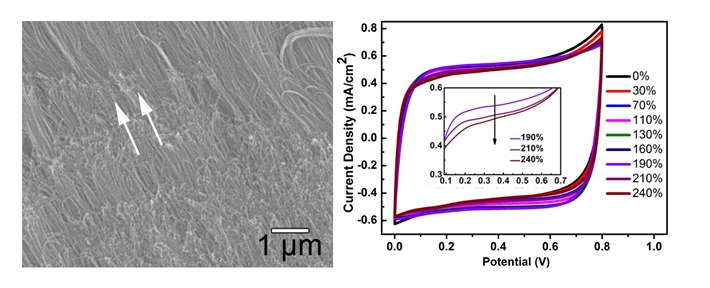|
With the rapid development of flexible electronics, stretchable energy storage devices, such as supercapacitors and lithium-ion batteries that can bear unpredictable tensile forces have attracted increasing attention. Compared with lithium-ion batteries, supercapacitors (also called electrochemical capacitors or ultracapacitors) have higher power densities, longer cycle lives, and easier fabricating processes, and are promising for use as power sources in portable electronics, electric or hybrid electric vehicles, especially for some fields requiring power with short-term acceleration and recovery. Therefore, stretchable supercapacitors have been widely investigated, which can be easily realized by assembling two stretchable electrodes sandwiching a layer of gel electrolyte used as separator. However, stretchabilities of most developed supercapacitors were lower than 100 %, and the performance usually decreased shapely at high tensile strain. Furthermore, the specific capacitance of the developed stretchable supercapacitors was often lower than that of conventional devices. Both of the above mentioned problems can be ascribed to the limitation of the used electrodes. Therefore, highly stretchable supercapacitors with high specific capacitance may be achieved by optimizing the used electrodes and active materials.

The results of the study were published in the internationally acclaimed journal Angew. Chem. Int. Ed., entitled Highly Stretchable Supercapacitors Based on Aligned Carbon Nanotube / Molybdenum Disulphide Composites. The thesis is based on post-doctorate Lv Tian as the first author, Professor Tao Tao as the only communication contact person, Tongji University as the only communication unit. Angew. Chem. Int. Ed. Is one of the most authoritative comprehensive journals in chemistry, with a current impact factor of 11.7.
|